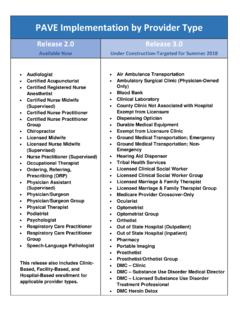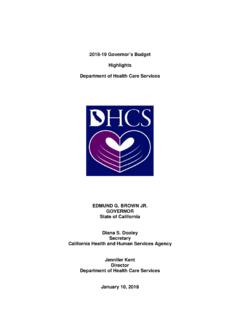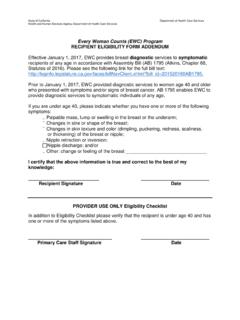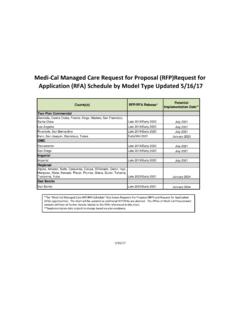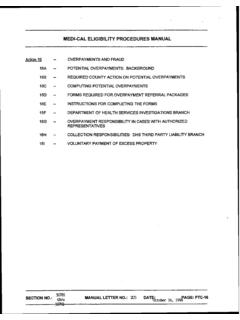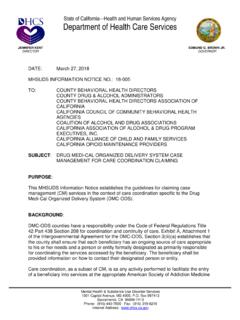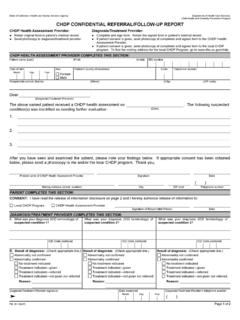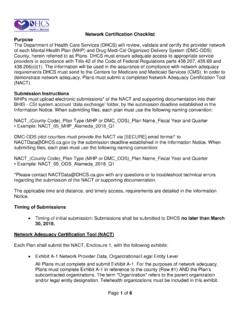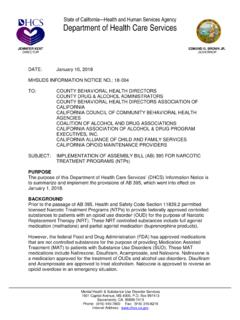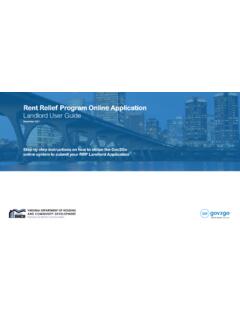Transcription of Medi-Cal Manual Third Edition ADA - California
1 Medi-Cal Manual . For Intensive Care Coordination (ICC), Intensive Home Based Services (IHBS), and Therapeutic Foster Care (TFC) Services for Medi-Cal Beneficiaries Third Edition January 2018. INTENTIONALLY BLANK PAGE. TABLE OF CONTENTS. TABLE OF CONTENTS ..3. CHAPTER 1: Purpose and Background .. 6. Specialty Mental Health Services (SMHS) ..7. Katie A. v. Bont Settlement ..7. Chapter 2: Target Population ..9. ICC and TFC ..11. Chapter 3: Principles of the Integrated Core Practice Model .. 13. ICPM Description ..13. ICPM Values and Principles ..13. Chapter 4: The Child and Family Team .. 15. CFT Overview ..15. Composition of Child and Family Teams ..16. Confidentiality ..18. CFT Meeting ..18. When to Convene a CFT Meeting ..19. CFT Meeting Frequency, Location, and Logistics ..20. CFT Meeting Preparation ..20. CFT Meeting Facilitation ..21. Claiming and Reimbursement ..21. CHAPTER 5: ICC, IHBS, and TFC .. 23. Planning for ICC, IHBS, and TFC ..23. INTENSIVE CARE COORDINATION (ICC) ..23. ICC General Description.
2 23. ICC Service Components and Activities ..25. Medi-Cal Documentation Requirements of ICC Service Components and Activities .. 28. ICC Provider ICC Service Authorization ..28. Coordination of ICC with Other Speciality Mental Health Services ..29. ICC Service Settings / Limitations / ICC Claiming and Reimbursement ..30. INTENSIVE HOME BASED SERVICES (IHBS) ..30. IHBS General Description ..30. IHBS Service Components and Activities ..31. Medi-Cal Documentation of IHBS Service Components and Activities ..32. IHBS Provider Qualifications ..32. IHBS Service Coordination of IHBS with Other SMHS ..32. IHBS Service Settings ..33. IHBS Service Limitations and IHBS Claiming and THERAPEUTIC FOSTER CARE (TFC) ..34. TFC General Role of the TFC Agency ..34. Role of the TFC Parent ..36. TFC Parent Required Qualifications ..37. TFC Components and Activities ..40. Documentation of TFC Components and Activities ..46. TFC Service Authorization ..46. Coordination of TFC with Other SMHS ..47. TFC Settings / Limitations / TFC Claiming and Reimbursement.
3 48. APPENDIX 49. Glossary ..49. APPENDIX B .. 57. Sample ICC and IHBS Progress Notes ..57. Sample 1: ICC Progress Note ..58. Sample 2: IHBS Progress Note ..60. APPENDIX C .. 61. Sample TFC Progress Notes ..61. Sample 1: TFC Progress Sample 2: TFC Progress Sample 3: TFC Progress Instructions for TFC Progress Note ..68. APPENDIX 70. Non-Reimbursible Activities ..70. 72. If you have questions regarding obtaining ICC, IHBS, or TFC for an eligible child or youth, please contact your County Mental Health Plan (MHP). A list of County MHP's toll free numbers can be located at: You also may contact the Mental Health Services Division, at the Department of Health Care Services (DHCS), at (916) 322-7445, or email your questions to DHCS at: In addition, you may email your questions to the California Department of Social Services (CDSS) at: CHAPTER 1: PURPOSE AND BACKGROUND. PURPOSE In addition to this Manual , other federal and state documents related to the The purpose of this Manual is to provide delivery of SMHS in the State of Mental Health Plans (MHPs), Medi-Cal California should be consulted to obtain providers, children and youth, families, more information on SMHS.
4 These county representatives, and other documents include, but are not stakeholders with information regarding limited to: Intensive Care Coordination (ICC), Intensive Home Based Services (IHBS), Federal Medicaid laws and and Specialty Mental Health regulations Services (SMHS) service activities California Code of Regulations provided through the Therapeutic Foster (CCR), Title 9, Division 1, Care service model (referred to as Chapter 11, TFC hereinafter). These services are California Medicaid State Plan, available, when medically necessary, to correct or ameliorate defects and mental DHCS contract with MHPs, illnesses or conditions through the Early DHCS/CDSS Core Practice Model and Periodic Screening, Diagnosis, and (CPM) Guide 1;. Treatment (EPSDT) benefit. DHCS Mental Health Substance Use This benefit is available to beneficiaries, Disorder Services (MHSUDS). up to age of 21, who are eligible for full Information Notices, as well as former scope Medi-Cal (42 1396a (a) Department of Mental Health Policy (43) and 42 1396d (r)).
5 Letters and Department of Mental Health Information Notices. This Manual provides information and guidelines for the delivery and billing of ICC, IHBS, and TFC. Please note that This Manual will be maintained by MHPs and providers should continue to DHCS and reviewed and updated, as provide other existing SMHS to children needed. The most recent version of this and youth, when medically necessary. Manual can be found on the DHCS. Katie A. webpage. Any questions concerning the information contained in this Manual should be directed to: 1As of January 2018, a draft of the ICPM is being finalized. Page 6 of 72. BACKGROUND KATIE A. V. BONT . SETTLEMENT. SPECIALTY MENTAL As a result of the Settlement agreement HEALTH SERVICES (SMHS) in Katie A. v. Bont , the State of California agreed to take a series of California administers a actions that transformed the way Section 1915 (b) Freedom of Choice California children and youth who are in Waiver for SMHS, using a managed foster care, or who are at imminent risk care model of service delivery.
6 DHCS of foster care placement, 2 receive operates and oversees this waiver, and access to mental health services. The contracts with county MHPs for the settlement specifically changed the way provision of SMHS. Each MHP a defined group of children and youth provides, or arranges for, SMHS for with the most intensive needs, referred Medi-Cal beneficiaries (children, youth, to as Katie A. subclass members , are and adults) who meet medical assessed for mental health services. necessity criteria. Pursuant to the settlement, subclass The following is a list of available SMHS members were required to be provided (see the glossary for descriptions): an array of services, and specifically medically necessary ICC, IHBS, and Mental Health Services, TFC, consistent with the Core Practice Crisis Intervention Services, Model (CPM). 3. Crisis Stabilization Services, The Settlement agreement had the Day Treatment Intensive Services, following objectives: Day Rehabilitation Services, Facilitate the provision of an array of Adult Residential Services, services delivered in a coordinated, Crisis Residential Services, comprehensive, community-based Medication Support Services, fashion that combines service access, planning, delivery, and Psychiatric Health Facility Services, transition into a coherent and all- Psychiatric Inpatient Hospital inclusive approach.
7 Services, Support the development and Targeted Case Management delivery of a service structure and a Services, fiscal system that supports a core Therapeutic Behavioral Services, practices and services model, as Intensive Care Coordination, described in the previous bullet;. Intensive Home Based Services, and Therapeutic Foster Care. 2 As defined in the Settlement agreement . 3 Now referred to as the Integrated Core Practice Model". Page 7 of 72. Support an effective and sustainable Reduce timelines to permanency solution, that will involve standards and lengths of stay within the child and methods to achieve quality- welfare system; and based oversight, along with training Reduce reliance on congregate care. and education that support the practice and fiscal models; While the Katie A. Settlement only concerned children and youth in foster Address the need for certain class care, or at imminent risk of placement in members with more intensive needs (hereinafter referred to as Katie A.)
8 Foster care, membership in the subclass members ) to receive Katie A. class or subclass is no medically necessary mental health longer a requirement for receiving services in the child's or youth's own medically necessary ICC, IHBS, and home, a family setting, or the most TFC. Therefore, a child or youth need homelike setting appropriate to the not have an open child welfare services child's or youth's needs, in order to case to be considered for receipt of ICC, facilitate reunification, and to meet IHBS, or TFC. 4. the child's or youth's needs for safety, permanence, and well-being;. Utilize the CPM principles and components, including: o A strong engagement with, and participation of, the child/youth and the family;. o Focus on the identification of child/youth and family needs and strengths when assessing and planning services;. o Teaming across formal and informal support systems; and o Use of Child and Family Teams (CFTs) to identify strengths and needs, make plans and track progress, and provide intensive home-based services.
9 Assist, support, and encourage each eligible child/youth to achieve and maintain the highest possible level of health, well-being, and self-sufficiency;. 4 See MHSUDS Information Notice 16-004. Page 8 of 72. CHAPTER 2: TARGET POPULATION. ICC AND IHBS Other entities, such as juvenile probation, have an affirmative ICC and IHBS are provided through the responsibility to screen and refer EPSDT benefit to all children and youth children and youth who may be in need who: of ICC and IHBS. Are under the age of 21; MHPs have an affirmative responsibility Are eligible for the full scope of to determine if children and youth who Medi-Cal services; and meet medical necessity criteria need Meet medical necessity criteria for ICC and IHBS. SMHS. 5 The following criteria should be ICC and IHBS must be provided to all considered as indicators of need for ICC. children and youth who meet medical and IHBS, and are intended to be used necessity criteria for those services. to identify children and youth who Membership in the Katie A.
10 Subclass is should be assessed for whether ICC. not a prerequisite to receiving ICC and and/or IHBS are medically necessary. IHBS. (DHCS MHSUDS Information Thus, ICC and IHBS are very likely to be Notice No: 16-004.). 6 medically necessary for children and youth who meet the following criteria. MHPs must make individualized These criteria are not requirements or determinations of each child's/'youth's conditions, but are provided as need for ICC and IHBS, based on the guidance, in order to assist counties in child's/youth's strengths and needs. As identifying children and youth who are in discussed below, these services are need of ICC and IHBS. appropriate for children and youth with more intensive needs who are in, or at ICC and IHBS are very likely to be risk of, placement in residential or medically necessary for children and hospital settings, but could be effectively youth who: served in the home and community. Are receiving, or being considered Child welfare departments have an for, Wraparound.
